| The 400 Blows (Les quatre cents coups) | Director: François Truffaut | | Screenplay: François Truffaut & Marcel Moussy (story by François Truffaut) | | Stars: Jean-Pierre Léaud (Antoine Doinel), Claire Maurier (Gilberte Doinel, the Mother), Albert Rémy (Julien Doinel), Guy Decomble (“Petite Feuille,” the French teacher), Georges Flamant (Mr. Bigey), Patrick Auffray (Rene) | | MPAA Rating: NR | | Year of Release: 1959 | | Country: France | | Stolen Kisses (Baisers voles) | Director: François Truffaut | | Screenplay: François Truffaut & Claude de Givray & Bernard Revon | | Stars: Jean-Pierre Léaud (Antoine Doinel), Claude Jade (Christine Darbon), Delphine Seyrig (Fabienne Tabard), Michel Lonsdale (Georges Tabard), Daniel Ceccaldi (Monsieur Darbon), Claire Duhamel (Madame Darbon), Harry-Max (Monsieur Henri), André Falcon (Monsieur Blady), Serge Rousseau (L'incconnu), Catherine Lutz (Catherine) | | MPAA Rating: R | | Year of Release: 1968 | | Country: France | | Bed and Board (Domicile conjugal) | Director: François Truffaut | | Screenplay: François Truffaut & Claude de Givray & Bernard Revon | | Stars: Claude Jade (Christine Doinel), Jean-Pierre Léaud (Antoine Doinel), Daniel Ceccaldi (Monsieur Darbon), Claire Duhamel (Madame Darbon), Hiroko Berghauer (Kyoko), Barbara Laage (Monique), Silvana Blasi (Silvana), Daniel Boulanger (Tenor), Danièle Girard (Ginette) | | MPAA Rating: PG | | Year of Release: 1970 | | Country: France | | Love on the Run (L’amour en fuite) | Director: François Truffaut | | Screenplay: François Truffaut & Marie-France Pisier & Jean Aurel & Suzanne Schiffman | | Stars: Jean-Pierre Léaud (Antoine Doinel), Claude Jade (Christine Doinel), Marie-France Pisier (Colette Tazzi), Dani (Liliane), Dorothée (Sabine Barnerias), Daniel Mesguich (Xavier the Librarian), Julien Bertheau (Monsieur Lucien), Jean-Pierre Ducos (Christine's Lawyer), Marie Henriau (Divorce Judge), Julien Dubois (Alphonse Doinel), Rosy Varte (Colette's Mother) | | MPAA Rating: PG | | Year of Release: 1979 | | Country: France | 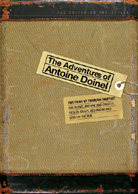 |
| In the early 1950s, with the help of noted film theorist and critic André Bazin, 20-year-old François Truffaut began writing regularly for the Parisian film journal Cahiers du cinéma. He quickly gained a reputation as an uncompromising and often vicious critic with a clear-cut sense of what was great about the cinema—he openly took aim on such previously untouchable French masters as Marcel Carné and René Clair. When he married Madeleine Morgenstern, the daughter of a film distributor whose films Truffaut often lambasted in his critical writings, his new father-in-law said, “If you know so much, why don’t you make a film?” 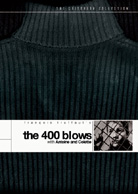 Famous last words, as they say. Truffaut took him up on his offer, and the result was The 400 Blows ( Les quatre cents coups), a film that would forever change the landscape of not only the French cinema, but cinema worldwide. It is hard to imagine that such a seemingly simple film, a loosely autobiographical portrait of youth in revolt (the title comes from the phrase “fait les quatre cents coups,” which means “to raise hell”), would have such a lasting impact, but the result is undeniable. Although not technically the first film of the vaunted French New Wave, The 400 Blows received such critical and commercial success that it empowered Truffaut, and the movement as a whole, in a way that no other film did. Films by Jean-Luc Godard, Eric Rohmer, and Jacques Rivette followed soon after, and the cinematic landscape would never be the same again. Famous last words, as they say. Truffaut took him up on his offer, and the result was The 400 Blows ( Les quatre cents coups), a film that would forever change the landscape of not only the French cinema, but cinema worldwide. It is hard to imagine that such a seemingly simple film, a loosely autobiographical portrait of youth in revolt (the title comes from the phrase “fait les quatre cents coups,” which means “to raise hell”), would have such a lasting impact, but the result is undeniable. Although not technically the first film of the vaunted French New Wave, The 400 Blows received such critical and commercial success that it empowered Truffaut, and the movement as a whole, in a way that no other film did. Films by Jean-Luc Godard, Eric Rohmer, and Jacques Rivette followed soon after, and the cinematic landscape would never be the same again.
The 400 Blows introduced the unfortgettable character of Antoine Doinel, a romantic who would become the central figure of a quintet of films over two decades, offering an unparalleled opportunity to watch a character grow and mature on-screen. Doinel was played in all his incarnations by Jean-Pierre Léaud, who became as much a part of the character as Truffaut, on whose life Antoine was modeled. In The 400 Blows, Antoine is an irrepressible 12-year-old who lashes out against all the authorial figures bent on keeping him in line, whether it be his sadistic French teacher (Guy Decomble) or his working-class parents (Claire Maurier and Albert Rémy), who are much like Truffaut’s own parents, not bad people, just “nervous and busy,” in Truffaut’s own words. Léaud’s performance is a marvel, as he conveys Antoine’s frustration with the world around him and the inability of adults to understand him. More importantly, though, he conveys the sense that he doesn’t always understand his own actions. They are often the results of an impulsivity that arises from deep within his own rebellion, which in turn is born of an idealized romanticism that defines his character. Yet, he is determined to take responsibility for his actions, however impulsive and ill-thought, which gives the film a crucial existential thread that came to characterize much of Truffaut’s work, particularly the Antoine Doinel films. The famous final freeze-frame that ends The 400 Blows is a perfect summation of the film’s themes of individuality and personal responsibility. Shot in gorgeous black and white anamorphic widescreen by Henri Decaë, who started as a documentarian in World War II and later worked with such French luminaries as Louis Malle, Claude Chabrol, and Roger Vadim, The 400 Blows expertly captures the day-to-day rhythms of life in Paris in the late 1950s, strikingly foregrounding the French New Wave’s characteristic insistence on location photography. Whether the scene is taking place in the regimented classroom of Antoine’s school, the busy Parisian streets, or the cramped apartment where he lives with his parents, the film conveys a gritty sense of being there that is neither highly stylized nor flat and documentary-like; it is a unique visual achievement that made the film stand out from both previous French films that prided themselves on being “cinema of quality” and the heavily studio-bound products of U.S. producers and their Production-Code-limited subject matter. The achievement of The 400 Blows was best summed up by fellow New Wave director Jean-Luc Godard in his review of the film in Cahiers: “the proudest, stubbornest, most obstinate, in other words most free, film in the world.” Three years later, Truffaut revisited the character of Antoine Doinel, not in feature-length film, but rather in a 30-minute short film, Antoine and Colette, which was part of a larger international anthology titled L’amour à vingt ans (Love at Twenty) that included other segments on the theme of young love directed by Shintarô Ishihara, Marcel Ophüls, Renzo Rossellini, and Andrzej Wajda. Truffaut’s segment is clearly the best of the group, as it effortlessly conveys the pains of idealized and ultimately unrequited love in simple, human terms. Antoine, now 17 years old, is employed and living on his own just as he always wanted. One night at a concert, he sees a young woman named Colette (Marie-France Pisier), a student who stills lives at home with her parents. The romantic in him is stirred, and Antoine begins to pursue a relationship with her. He becomes friends with her and they spend a great deal of time together, but she clearly does not return the romantic longings he has for her. Truffaut gives us scenes that are almost obligatory in any story about young love, yet infuses each one with a freshness and integrity that makes the film compelling despite the obviousness of the material. Antoine is doubly pained in that he is openly welcomed by Colette’s parents (Rosy Varte and François Darbon), and in the end finds himself with them, rather than Colette. The final shot of him sitting on the couch between them watching TV while Colette is out with another boy packs almost the same emotional punch as the freeze-frame that ends The 400 Blows. 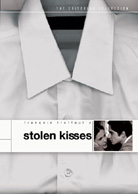 It would be six more years before Antoine Doinel graced the silver screen again, this time in 1968’s Stolen Kisses (Baisers voles), which marked two significant changes from the previous two films. First, it was the first to split entirely from Truffaut’s autobiography. While it opens with Antoine being dishonorably discharged from the military for “instability of character” after going AWOL (numerous times), which happened to Truffaut, the rest of the film veers entirely into the realm of fiction, which is where the final two Antoine Doinel films would reside, as well. Secondly, Stolen Kisses marked a decisive change in tone from The 400 Blows and Antoine and Colette. Whereas those films were primarily dramas with moments of dark humor, Stolen Kisses plays primarily as a comedy, almost a farce at times, with Antoine assuming a job in a detective agency and making a mess of the assignments given to him. It would be six more years before Antoine Doinel graced the silver screen again, this time in 1968’s Stolen Kisses (Baisers voles), which marked two significant changes from the previous two films. First, it was the first to split entirely from Truffaut’s autobiography. While it opens with Antoine being dishonorably discharged from the military for “instability of character” after going AWOL (numerous times), which happened to Truffaut, the rest of the film veers entirely into the realm of fiction, which is where the final two Antoine Doinel films would reside, as well. Secondly, Stolen Kisses marked a decisive change in tone from The 400 Blows and Antoine and Colette. Whereas those films were primarily dramas with moments of dark humor, Stolen Kisses plays primarily as a comedy, almost a farce at times, with Antoine assuming a job in a detective agency and making a mess of the assignments given to him.
Yet, despite some of the broadness of the comedy (one of the funniest scenes being Antoine’s clearly inept attempt to tail a woman on the street), the film is tempered throughout by a series of lessons Antoine learns about the nature of the adult world and love within it. Still the hopeful romantic, Antoine comes into contact with a number of characters, all of whom have somehow been defeated by life. One of the saddest is Georges Tabard (Michel Lonsdale), the successful owner of a shoe shop who hires Antoine to pose as a stockboy to find out why all his employees despise him. Antoine ends up falling in love with Tabard’s life, Fabienne (Delphine Seyrig), who he describes as “an apparition.” But, as she bluntly tells him at one point, she is not an apparition, but rather a woman, and it is that lesson in the difference between idealized visions of those we love and how they are in reality that marks one of Antoine’s decisive steps into maturity. As each film shows him growing both physically and emotionally, Stolen Kisses primarily depicts his crossing over from childhood, where responsibility is something that is desired, to adulthood, where it is something that cannot be avoided. 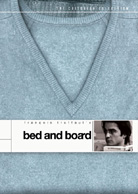 In Bed and Board (Domicile conjugal), released only two years later, Antoine is in the thralls of young adulthood, but still trying to find his way in the world. Although he is married to his longtime off-again-on-again girlfriend Christine (Claude Jade), who teaches violin lessons to children, Antoine is still not settled. He bounces from one job to the next, in this case moving from being employed by a flower shop where he dyes carnations to working for a large American corporation maneuvering radio-controlled boats in a giant tank (the increasing silliness of his employment reaches its apotheosis here). In Bed and Board (Domicile conjugal), released only two years later, Antoine is in the thralls of young adulthood, but still trying to find his way in the world. Although he is married to his longtime off-again-on-again girlfriend Christine (Claude Jade), who teaches violin lessons to children, Antoine is still not settled. He bounces from one job to the next, in this case moving from being employed by a flower shop where he dyes carnations to working for a large American corporation maneuvering radio-controlled boats in a giant tank (the increasing silliness of his employment reaches its apotheosis here).
Bed and Board largely carries over the romantic-comedy vibe of Stolen Kisses, allowing us to observe Antonine and Christine’s various trials and tribulations with a sense of slightly bemused distance that never fully intrudes on our ability to recognize and appreciate the dramatic undercurrents. Truffaut plays up the surrounding comedy a bit more this time, particularly a squabbling married couple who lives next-door to Antoine and Christine and might very well represent their future together. There is a sense of community in this film that was somewhat lacking in the previous Doinel films, as Truffaut emphasizes reoccurring characters and their relations to each other in the small neighborhood where Antoine and Christine live. Of course, romanticism and the nature of love are still crucial themes, this time centering around the difficulties of young marriage and the enormous step into parenthood. Although they clearly love each other, Antoine and Christine are not without their problems, especially once Antoine foolishly engages in an affair with a Japanese woman named Kyoko (Hiroko Berghauer), who at first represents all that is exotic and entrancing, but is ultimately revealed to be a static bore. Lovable as he is, Antoine reveals some of his most selfish tendencies in the last third of Bed and Board, although the film ends on a light comic touch to suggest that, difficult as life is, both he and Christine will make it through. 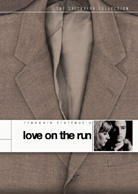 However, seven year later, with the release of the final Antoine Doinel film, Love on the Run (L’amour en fuite), we find that is not the case. Despite the fact that they reconcile Antoine’s infidelity at the end of Bed and Board, it turns out that Antoine and Christine are not meant to be together. When the film opens, he is just getting out of the bed of another woman, Sabine (Dorothée), who is clearly infatuated with him even though he seems reluctant to make any sort of commitment. Still the harried romantic, Antoine is so caught up in his romantic entanglements that he very nearly misses his own divorce, just as he missed the birth of his son. The gray boundaries between Antoine’s romanticism, self-centeredness, and simple absent-mindness by this point have all coalesced into one. However, seven year later, with the release of the final Antoine Doinel film, Love on the Run (L’amour en fuite), we find that is not the case. Despite the fact that they reconcile Antoine’s infidelity at the end of Bed and Board, it turns out that Antoine and Christine are not meant to be together. When the film opens, he is just getting out of the bed of another woman, Sabine (Dorothée), who is clearly infatuated with him even though he seems reluctant to make any sort of commitment. Still the harried romantic, Antoine is so caught up in his romantic entanglements that he very nearly misses his own divorce, just as he missed the birth of his son. The gray boundaries between Antoine’s romanticism, self-centeredness, and simple absent-mindness by this point have all coalesced into one.
Love on the Run pulls together many of the characters and themes that had floated throughout the previous films. In particular, Antoine again crosses paths with Colette, the young woman from the concerts who did not return his affections in Antoine and Colette. Now a lawyer and herself divorced, Colette finds that little has changed about Antoine despite his having reached full adulthood (physically, at least). There is an extended sequence on a train in which the two of them are together, and it is a satisfying feeling to see the two characters interact again after such a long separation—so rare it is in film to be able to see characters grow and evolve over time and cross paths again. The same goes for Antoine’s surprise run-in with his mother’s lover, Lucien (Julien Bertheau), who he saw on the street as a child and who gives him the opportunity to bring his difficult relationship with his mother to some sort of closure. Much of the film’s running time consists of clips from the previous films that are used as flashbacks, clearly signaling that Love on the Run is the chapter that will close the saga of Antoine Doinel’s screen life (we can only imagine where he goes from here). His romance with Sabine is as complicated and unstable as all of his other relationships, and it turns out that two of his former flames, Christine and Colette, play a pivotal role in helping him find happiness. Love on the Run is not the best of the Doinel films, but it brings to a satisfying end the story of an unforgettable character whose lifelong pursuit of romance and responsibility in a world seemingly bent on keeping him down may have finally found fruition. | The Adventures of Antoine Doinel Criterion Collection DVD Box Set | | | Aspect Ratio | 2.35:1 (The 400 Blows, Antoine and Colette). 1.66:1 (Stolen Kisses, Bed and Board, Love on the Run) | | Languages | French | | Subtitles | English | | Distributor | The Criterion Collection / Home Vision Entertainment | | Release Date | April 29, 2003 | | SRP | $99.95 (each) | | | VIDEO | 2.35:1 (The 400 Blows and Antoine and Colette, 1.66:1 (Stolen Kisses, Bed and Board and Love on the Run) (Anamorphic)
Each of these important films is presented in a pristine new high-definition anamorphic transfer that looks great. Criterion had previously released the The 400 Blows as one of its firs DVDs back in 1998 without an anamorphic transfer, and the new one, which was taken from a 35mm composite fine-grain master, is a significant improvement, with better detail and a more striking reproduction of the strong contrasts in the black-and-white photography. The other films (with the exception of Antoine and Colette), were all filmed in color, and each transfer faithfully reproduces the hues and saturation of the original film stock, giving each a decidedly pleasing film-like appearance. Stolen Kisses and Love on the Run were transferred from 35mm interpositives, while Bed and Board was transferred from original masters. The results are uniformly excellent, nothing less than we have come to expect from Criterion. | | | AUDIO | French Dolby Digital 1.0 Monaural
Each of the films is presented in its original monaural mix. As all of these films are dialogue heavy, the clean one-channel soundtracks are more than adequate. Each film also offers new and improved English subtitles. | | | SUPPLEMENTS | | Criterion has released these five films in a beautifully designed box set that is laden with a host of fascinating supplements. Put together, all the supplements, which consist of audio commentaries, interview excerpts, audition footage, and tons of original newsreel footage, form a comprehensive exploration of François Truffaut’s indelible career and the development of one of the most memorable recurring characters in screen history. Simply put, this is what Criterion does best. To be honest, I have not had a chance to go through every single supplement because there are so many. For those with hours of time and an insatiable appetite for information, this box set offers tons of compelling material. With that in mind, I am simply going to list the plethora of supplements with the blanket statement that every one I have gone through has been worth the time and effort: Disc One: The 400 Blow and Antoine and Colette Two audio commentaries: One by cinema professor Brian Stonehill and one by Truffaut’s lifelong friend Robert LachenayRare audition footage of Jean-Pierre Léaud, Patrick Auffay, and Richard KanayanNewsreel footage of Jean-Pierre Léaud in Cannes for the screening of The 400 BlowsExcerpt from a TV interview with TruffautTheatrical trailerDisc Two: Stolen Kisses Introduction by film historian Serge ToubianaExcerpt from interview with Truffaut on the TV show Cinéastes de potre temps: François Truffaut, dix ans, dix filmsArchival newsreel footage of the “Langlois Affair”Promotional spot feating Jean-Luc Godard and François Truffaut appeaing for public support of LangloisNewsreel footage of Truffaut’s rally to shut down the Cannes Film FestivalTheatrical trailerDisc Three: Bed and Board Behind-the-scenes footage of Truffaut on the setExcerpts from the 1970 TV show Cinéastes de potre temps: François Truffaut, dix ans, dix filmsTV interview with Jean-Pierre LéaudExcerpts from 1972 documentary Approaches due cinéma: François Truffaut ou la nouvelle vagueTheatrical trailerDisc Four: Love on the Run TV interview with Truffaut and actress/cowriter Marie-France PisierExcerpt from 1980 interview with Truffaut on the TV show CinescopeTheatrical trailerAnd, as if that weren’t enough, Criterion has also put together a fifth disc that contains even more materials, as well as beautifully designed insert book (and when I say book, I mean it—this ain’t no stapled booklet, but rather a perfect-bound book of 72 pages) that contains an extensive array of articles, interviews, treatments, and press book excerpts. Disc Five: Les salades de l’amour: The Supplements Les mistons (The Mishief Makers 1957 short film directed by Truffaut (18 min., also includes an audio commentary by assistant director Claude de Givray)Working With François Truffaut: Claude de Givrary and Bernard Revon, Co-Writers 44-minute interview culled from raw footage of a 1986 interview with two of Truffaut’s collaboratorsAudio/visual “primer” for Les mistons by film historian Serge ToubianaExcerpt from 1961 documentary François TruffautTruffaut interview from 1981 TV show Champ contre champPromotional art galley |
© 2003 James Kendrick |



 (4)
(4)

 Famous last words, as they say. Truffaut took him up on his offer, and the result was The 400 Blows ( Les quatre cents coups), a film that would forever change the landscape of not only the French cinema, but cinema worldwide. It is hard to imagine that such a seemingly simple film, a loosely autobiographical portrait of youth in revolt (the title comes from the phrase “fait les quatre cents coups,” which means “to raise hell”), would have such a lasting impact, but the result is undeniable. Although not technically the first film of the vaunted French New Wave, The 400 Blows received such critical and commercial success that it empowered Truffaut, and the movement as a whole, in a way that no other film did. Films by Jean-Luc Godard, Eric Rohmer, and Jacques Rivette followed soon after, and the cinematic landscape would never be the same again.
Famous last words, as they say. Truffaut took him up on his offer, and the result was The 400 Blows ( Les quatre cents coups), a film that would forever change the landscape of not only the French cinema, but cinema worldwide. It is hard to imagine that such a seemingly simple film, a loosely autobiographical portrait of youth in revolt (the title comes from the phrase “fait les quatre cents coups,” which means “to raise hell”), would have such a lasting impact, but the result is undeniable. Although not technically the first film of the vaunted French New Wave, The 400 Blows received such critical and commercial success that it empowered Truffaut, and the movement as a whole, in a way that no other film did. Films by Jean-Luc Godard, Eric Rohmer, and Jacques Rivette followed soon after, and the cinematic landscape would never be the same again. It would be six more years before Antoine Doinel graced the silver screen again, this time in 1968’s Stolen Kisses (Baisers voles), which marked two significant changes from the previous two films. First, it was the first to split entirely from Truffaut’s autobiography. While it opens with Antoine being dishonorably discharged from the military for “instability of character” after going AWOL (numerous times), which happened to Truffaut, the rest of the film veers entirely into the realm of fiction, which is where the final two Antoine Doinel films would reside, as well. Secondly, Stolen Kisses marked a decisive change in tone from The 400 Blows and Antoine and Colette. Whereas those films were primarily dramas with moments of dark humor, Stolen Kisses plays primarily as a comedy, almost a farce at times, with Antoine assuming a job in a detective agency and making a mess of the assignments given to him.
It would be six more years before Antoine Doinel graced the silver screen again, this time in 1968’s Stolen Kisses (Baisers voles), which marked two significant changes from the previous two films. First, it was the first to split entirely from Truffaut’s autobiography. While it opens with Antoine being dishonorably discharged from the military for “instability of character” after going AWOL (numerous times), which happened to Truffaut, the rest of the film veers entirely into the realm of fiction, which is where the final two Antoine Doinel films would reside, as well. Secondly, Stolen Kisses marked a decisive change in tone from The 400 Blows and Antoine and Colette. Whereas those films were primarily dramas with moments of dark humor, Stolen Kisses plays primarily as a comedy, almost a farce at times, with Antoine assuming a job in a detective agency and making a mess of the assignments given to him. In Bed and Board (Domicile conjugal), released only two years later, Antoine is in the thralls of young adulthood, but still trying to find his way in the world. Although he is married to his longtime off-again-on-again girlfriend Christine (Claude Jade), who teaches violin lessons to children, Antoine is still not settled. He bounces from one job to the next, in this case moving from being employed by a flower shop where he dyes carnations to working for a large American corporation maneuvering radio-controlled boats in a giant tank (the increasing silliness of his employment reaches its apotheosis here).
In Bed and Board (Domicile conjugal), released only two years later, Antoine is in the thralls of young adulthood, but still trying to find his way in the world. Although he is married to his longtime off-again-on-again girlfriend Christine (Claude Jade), who teaches violin lessons to children, Antoine is still not settled. He bounces from one job to the next, in this case moving from being employed by a flower shop where he dyes carnations to working for a large American corporation maneuvering radio-controlled boats in a giant tank (the increasing silliness of his employment reaches its apotheosis here). However, seven year later, with the release of the final Antoine Doinel film, Love on the Run (L’amour en fuite), we find that is not the case. Despite the fact that they reconcile Antoine’s infidelity at the end of Bed and Board, it turns out that Antoine and Christine are not meant to be together. When the film opens, he is just getting out of the bed of another woman, Sabine (Dorothée), who is clearly infatuated with him even though he seems reluctant to make any sort of commitment. Still the harried romantic, Antoine is so caught up in his romantic entanglements that he very nearly misses his own divorce, just as he missed the birth of his son. The gray boundaries between Antoine’s romanticism, self-centeredness, and simple absent-mindness by this point have all coalesced into one.
However, seven year later, with the release of the final Antoine Doinel film, Love on the Run (L’amour en fuite), we find that is not the case. Despite the fact that they reconcile Antoine’s infidelity at the end of Bed and Board, it turns out that Antoine and Christine are not meant to be together. When the film opens, he is just getting out of the bed of another woman, Sabine (Dorothée), who is clearly infatuated with him even though he seems reluctant to make any sort of commitment. Still the harried romantic, Antoine is so caught up in his romantic entanglements that he very nearly misses his own divorce, just as he missed the birth of his son. The gray boundaries between Antoine’s romanticism, self-centeredness, and simple absent-mindness by this point have all coalesced into one.